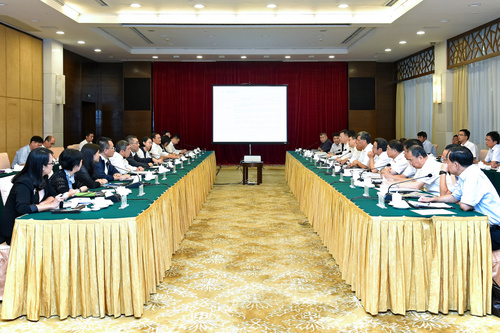 The Chief Executive, Mr Chui Sai On, leads a Government delegation to Guangzhou to discuss with the Governor of Guangdong Province, Mr Ma Xingrui, and appropriate departments, a proposal for a cross-boundary flood control system.
The Chief Executive, Mr Chui Sai On, leads a Government delegation to Guangzhou to discuss with the Governor of Guangdong Province, Mr Ma Xingrui, and appropriate departments, a proposal for a cross-boundary flood control system.
Macao is working diligently with Guangdong Province in order to hasten construction of a cross-boundary system to control flooding in Macao’s low-lying areas.
The Chief Executive, Mr Chui Sai On, today led a Government delegation to Guangzhou in Guangdong Province to exchange views on flood prevention with the Governor of Guangdong, Mr Ma Xingrui, and the Vice Governor, Mr Deng Haiguang.
The two sides agreed to strengthen communication – via the existing Guangdong-Macao cooperation framework – between appropriate departments of the two governments. This was in order to speed up coordination regarding the building of a flood prevention system, including initiating jointly an in-depth analysis for such a project.
Mr Chui stated he hoped to gain support from the Guangdong Provincial Government for a Macao proposal regarding a system for flood prevention that planned in not only Macao’s low-lying areas but also Zhuhai and Zhongshan.
The Chief Executive briefed Guangdong officials regarding the efforts and proposals made by the Macao Government over the years for the control of flooding in the city’s Inner Harbour area. Such work included a visit to Beijing in 2013 to meet officials from the State Oceanic Administration, the Ministry of Transport and the Ministry of Water Resources. Last week, the Macao Government received approval – granted in principle by the Central Government – to advance plans for a cross-boundary flood prevention system.
Typhoon Hato – the strongest recorded storm in Macao for 53 years – struck the city on 23 August, causing an estimated 11.47-billion-patacas-worth of economic losses. The storm also brought with it a 5.58-metre high tide, resulting in severe flooding in several low-lying areas across the city.
During his visit today, Mr Chui expressed his gratitude to the Standing Committee of the CPC Guangdong Provincial Committee and the Guangdong Provincial Government for their support in work to alleviate the effects of Typhoon Hato – in particular, in allocating resources to advance the relief effort. He also expressed his appreciation for Guangdong’s prompt response and the preparation for today’s meeting on the flood prevention topic with the Macao Government.
During the meeting, Mr Ma passed on his sympathies regarding the damage created by the typhoon and spoke highly of the Macao Government’s relief effort and search and rescue work.
Government officials involved in today’s meeting in Guangzhou included: the Secretary for Transport and Public Works, Mr Raimundo Arrais do Rosário; the Chief-of-Office of the Chief Executive’s Office, Ms O Lam; the Director of the Government Information Bureau, Mr Chan Chi Ping; the Director of the Protocol, Public Relations and External Affairs Office, Ms Lei Ut Mui; the Director of the Marine and Water Bureau, Ms Wong Soi Man; the Director of the Land, Public Works and Transport Bureau, Mr Li Canfeng; and Deputy Director of the Land, Public Works and Transport Bureau, Mr Cheong Ion Man.
Others attending the meeting included: the Secretary-General of the Guangdong Provincial Government, Mr Li Feng; the Chief of the General Office of the Guangdong Provincial Government, Mr Zhang Hu; the Deputy Secretary-General of the Guangdong Provincial Government, Mr Gu Xingwei; the Deputy Mayor of Zhuhai, Mr Liu Jiawen; and the Mayor of Zhongshan, Mr Jiao Lansheng.
View gallery


